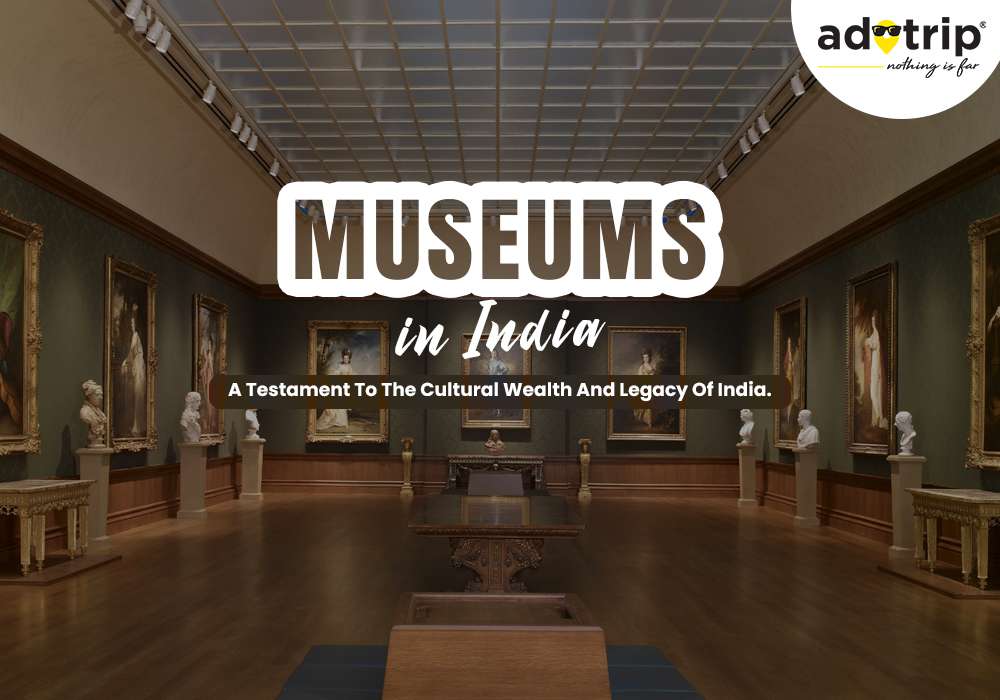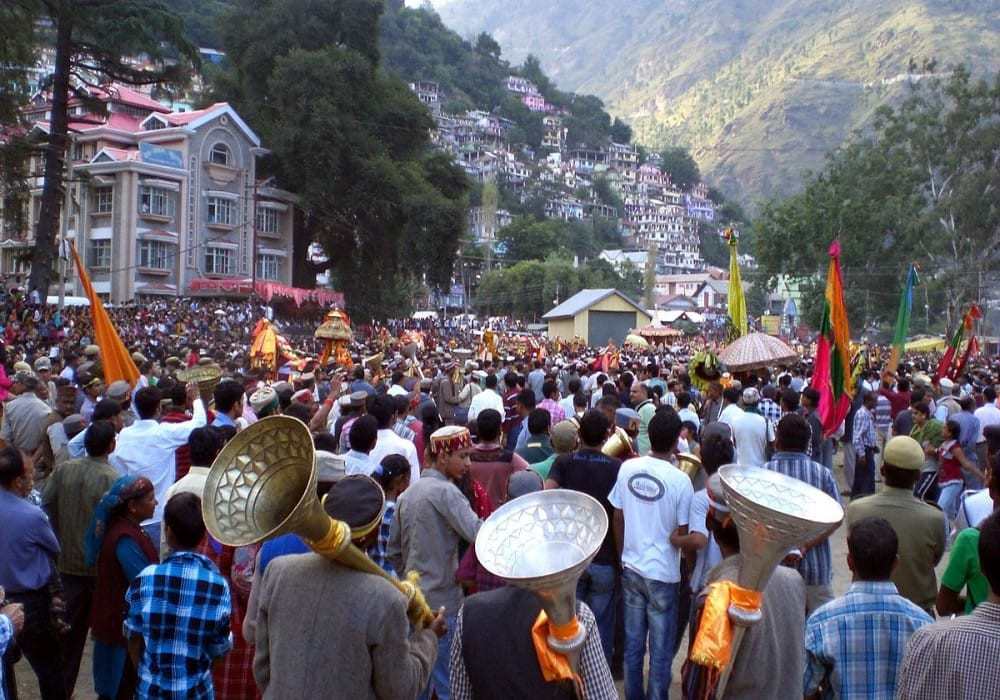
Last Updated At: 12-Dec-2023
12 Most Famous Museums in India in 2024
Museums in India are captivating spaces that serve as gateways to the country's rich and diverse cultural heritage. From ancient artefacts that speak of centuries-old civilisations to contemporary artworks that reflect the nation's vibrant artistic expressions, these places are custodians of India's past, present, and future. Museums in India showcase a vast array of treasures, including sculptures, paintings, textiles, manuscripts, coins, and historical objects that illuminate the nation's cultural, religious, and social fabric.
With their carefully curated exhibits and immersive displays, museums allow visitors to explore the intricacies of Indian history, traditions, and art forms. Beyond preservation and presentation, museums in India play a pivotal role in education, research, and cultural exchange. These museums provide platforms for learning, enabling visitors to deepen their understanding of India's heritage, engage in scholarly pursuits, and celebrate the rich tapestry of the country's extraordinary cultural legacy.
List of 12 Most Famous Museums in India
- National Museum, New Delhi
- Indian Museum, Kolkata
- Chhatrapati Shivaji Maharaj Vastu Sangrahalaya, Mumbai
- National Rail Museum, New Delhi
- Salar Jung Museum, Hyderabad
- Victoria Memorial Hall, Kolkata
- Madame Tussauds, New Delhi
- Dr. Bhau Daji Lad Museum, Mumbai
- Shankar's International Dolls Museum, New Delhi
- Jaipur City Palace Museum, Jaipur
- Napier Museum, Thiruvananthapuram
- Calico Museum of Textiles, Ahmedabad
1. National Museum, New Delhi
Established in the year 1949, the National Museum of India is located in New Delhi. The National Museum of India is renowned as a prominent and extensive museum in the country, exhibiting a diverse array of art, archaeology, and cultural artefacts that encompass a remarkable 5,000-year span of history. The museum showcases an astounding collection of jewellery, weapons, and decorative arts from the Mughal period, offering glimpses into that era's opulence and artistic excellence. This museum aims to preserve and exhibit India's rich cultural heritage, providing visitors with insights into the diverse art forms, traditions, and historical developments of the Indian subcontinent.
- Address: Janpath Rd, Rajpath Area, Central Secretariat, New Delhi, Delhi 110011
- Contact Details: +91 11 2301 9272; nationalmuseumoutreach@gmail.com
- Timings: 10 AM to 6 PM all days except Monday
Entry Fee:
- Indian Citizen - INR. 20 per person
- Foreign Tourists - INR. 650 per person
- Students with I-cards - Free
Where to buy tickets: Ticket counter
*Videography is prohibited within the museum premises, but handheld camera photography is permitted. However, prior permission must be obtained for the use of photographs.
2. Indian Museum, Kolkata
The Indian Museum, located in Kolkata, is the oldest museum in India. Established in 1814, this museum houses an extensive collection encompassing a wide range of disciplines, including archaeology, anthropology, art, geology, zoology, and more. The museum also exhibits an impressive collection of sculptures, including the iconic Bharhut Stupa and the Sanchi Stupa galleries, which display intricately carved Buddhist sculptures. The Indian Museum in Kolkata serves as a hub for research, conservation, and education. It organises exhibitions, seminars, and workshops to promote the understanding and appreciation of India's cultural and natural heritage.
- Address: 27, Jawaharlal Nehru Road, Park Street Area, Kolkata – 700016
- Contact Details: +91 033 2252 1790; indianmuseumkolkata@gmail.com
- Website: https://indianmuseumkolkata.org/
- Timings: 10 AM to 6 PM all days except Monday
Entry Fee:
- Indian Citizen - INR. 20 (below 18 years); INR. 50 per adult
- Foreign Tourists - INR. 500 per person
- Students with I-cards - Free
Where to buy tickets: Ticket counter/official website
Charges for photography with smartphone Camera is INR 50 + 18% GST and photography with DSLR Camera is INR 100 + 18% GST
3. Chhatrapati Shivaji Maharaj Vastu Sangrahalaya, Mumbai
Chhatrapati Shivaji Maharaj Vastu Sangrahalaya, formerly known as the Prince of Wales Museum, is a renowned museum located in Mumbai, Maharashtra. The museum is named after Chhatrapati Shivaji Maharaj, a famous Maratha king. It has an extensive collection of valuable artefacts from old cultures like Egypt, Greece, and China, which adds to the global importance of the museum. Ancient sculptures, detailed carvings, and religious artefacts from different times and parts of India can be seen in the galleries. The museum in India also has a large collection of Indian miniature paintings, decorative arts, and crafts that show the country's long history of art.
- Address: 159-161, Mahatma Gandhi Road, Fort, Mumbai-400 023. Maharashtra, India.
- Contact Details: +91 022 22844484 | 22844519; csmvsmumbai@gmail.com
- Website: https://csmvs.in/
- Timings: 10.15 AM to 6.00 PM all days
Entry Fee:
- Indian Citizen - INR 75 - 150
- Foreign Tourists - INR 700
- Students up to 10th with I-cards - INR. 35
Where to buy tickets: Ticket counter
Videography is prohibited within the museum premises. However, the entry fee includes the complimentary mobile photo pass and Rs.100 for a DSLR camera.
4. National Rail Museum, New Delhi
The National Rail Museum in New Delhi is an exciting place showcasing the rich history of the Indian Railways. With old trains, carriages, and other artefacts, this best museum in India shows how rail technology has changed over time. Some of the highlights include an indoor gallery with historical images and railway memorabilia, as well as the world's oldest operating steam engine, the Fairy Queen. Visitors can ride the joy train while gazing at interesting displays. The museum serves as an educational space, providing insights into the cultural significance and engineering aspects of the Indian Railways.
- Address: Near Bhutan Embassy, Shantipath, Chanakyapuri, New Delhi, Delhi, 110021, India
- Contact Details: +91 011 2688 0939; nationalrailmuseum@gmail.com
- Website: https://www.nrmindia.org/
- Timings: 10.00 AM to 5.00 PM all days except Monday
Entry Fee:
- Weekdays - INR 50 per adult; INR 10 per child
- Weekend - INR 100 per adult; INR 20 per child
Where to buy tickets: Ticket counter
Photography is allowed without any restrictions in the National Rail Museum in Delhi.
5. Salar Jung Museum, Hyderabad
The Salar Jung Museum is a globally renowned institution renowned for its extensive collection of art and artefacts. Located in Hyderabad, this museum in India was founded in 1951 and boasts diverse exhibits representing various cultures. The museum showcases a wide array of artworks, including paintings, textiles, manuscripts, and sculptures. The Veiled Rebecca and the Double Statue of Mephistopheles and Margaretta are among the museum's most acclaimed exhibits. With its vast collection and cultural importance, the Salar Jung Museum offers an enthralling exploration of the past, present, and future.
- Address: 22-8-299/320, Salar Jung Road, Darul Shifa, Hyderabad, Telangana, 500002
- Contact Details:+91 40 24576443, 24523211; salarjungmuseum1951@gmail.com
- Website:https://www.salarjungmuseum.in/index.html
- Timings: 10.00 AM to 5.00 PM all days except Friday
Entry Fee:
- Indian Citizen - INR 20
- Foreign Tourists - INR 500
- Students upto 10th with I-cards - Free
Where to buy tickets: Ticket counter
An additional fee of Rs. 50 is charged for the use of a still camera.
6. Victoria Memorial Hall, Kolkata
The Victoria Memorial Hall in Kolkata is widely regarded as one of the best museums in India. This impressive structure, dedicated to the remembrance of Queen Victoria, is a striking example of architectural mastery and historical import. The museum is home to priceless works of art and relics from India's colonial era. Visitors can explore galleries featuring paintings, sculptures, weapons, textiles, and historical documents. The memorial is made even more beautiful and peaceful by the magnificent grounds that surround it. The Victoria Memorial Hall is the jewel in India's museum crown due to its gorgeous architecture, rich collection, and cultural significance.
- Address: Victoria Memorial Hall, 1, Queen's Way, Kolkata - 700071
- Contact Details:91-33-2223-1890/189; victomem@gmail.com
- Website:https://victoriamemorial-cal.org/home/content/en
- Timings: 10.00 AM to 6.00 PM all days except Monday
Entry Fee:
- Indian Citizen - INR 30
- Foreign Tourists - INR 100-500
- Students upto 12th with I-cards - Free
Where to buy tickets: Ticket counter
Photography is permitted inside the galleries of the Victoria Memorial Hall, allowing visitors to capture memorable moments. However, the use of flashes or tripods while photographing the galleries is strictly prohibited.
7. Madame Tussauds, Noida
Madame Tussauds in India is an iconic attraction that offers visitors a unique opportunity to interact with lifelike wax figures of renowned personalities from various fields. From Bollywood stars and world leaders to sports icons and historical figures, the museum showcases a diverse collection of 50 meticulously crafted wax statues. Visitors can take selfies, pose with their favourite celebrities, and immerse themselves in a world of glamour and fame. With its realistic figures, interactive exhibits, and engaging ambience, Madame Tussauds provides an entertaining and memorable experience for visitors of all ages.
- Address: 4Th Floor, Dlf Mall Of India,, Noida, Uttar Pradesh
- Timings: 11.30 AM to 7.30 PM all days
Entry Fee:
- INR 960 for adults - 12 years and above
- INR 760 for Kids - 3 to 11 years
Where to buy tickets: Ticket counter
Visitors are encouraged to bring cameras, camera phones, and even selfie sticks to capture cherished moments and create lasting memories of their visit.
8. Dr. Bhau Daji Lad Museum, Mumbai
Located in the heart of Mumbai, the Dr Bhau Daji Lad Museum in India is a treasure trove of the city's history and art. One of Mumbai's oldest museums, it opened its doors in 1855. This Museum's exhibits range from antique sculptures to ornamental arts and focus on the city's cultural and aesthetic development over time. Visitors can gain a deeper appreciation for the city's history through the museum's rotating exhibits, workshops, and educational programmes.
- Address: 91/A, Dr. Babasaheb Ambedkar Road Byculla East, Mumbai 400027
- Contact Details: +91 22 2372 1234; education@bdlmuseum.org
- Website: https://www.bdlmuseum.org/index.php
- Timings: Temporarily closed for renovation
Entry Fee:
- Indian Citizen - INR. 5 - 10
- Foreign Tourists - INR. 30 - 100
- Students upto 12th with I-cards - INR.5
Visitors to the museum are allowed to capture photographs strictly for personal and non-commercial purposes.
9. Shankar's International Dolls Museum, New Delhi
The Shankar's International Dolls Museum is the oldest museum in India. This fascinating museum celebrates the beauty and diversity of dolls from around the globe. The museum, founded in 1965 by the late political cartoonist K. Shankar Pillai, is home to more than 6,500 dolls from around the world. These dolls are a fascinating look into the diverse cultural heritages of the world through their depiction of traditional dress and rituals. The museum is a wonderful place to visit, especially with kids, who can learn about different cultures while also enjoying the museum's collection of dolls.
- Address: 4, Nehru House, Bahadur Shah Zafar Road, Vikram Nagar, New Delhi, Delhi, 110002
- Contact Details: +91 11 2331 6970
- Timings: 10.00 AM to 6.00 PM all days except Monday
Entry Fee: INR 30 for adults and INR 13 for children
Photography is prohibited within the museum premises.
10. Jaipur City Palace Museum, Jaipur
The Jaipur City Palace Museum in Jaipur is a splendid architectural marvel that showcases the city's rich cultural heritage. Its stunning architecture reflects a fusion of Rajput, Mughal, and European styles, with intricately carved pillars, grand gateways, and ornate decorations. Within the palace complex, visitors can explore various attractions, including the Diwan-i-Khas (Hall of Private Audience), Mubarak Mahal (Palace of Welcome), and Chandra Mahal (Moon Palace). This museum in India is a remarkable collection of artefacts, paintings, and royal memorabilia, offering a captivating glimpse into the regal past of Jaipur.
- Address: Jaleb Chowk, Near Jantar Mantar, Kanwar Nagar, Jaipur, Rajasthan, 302002
- Contact Details: +91-141-4088888; information@royaljaipur.in
- Website: https://thecitypalacejaipur.com/
- Timings: 9.30 AM to 5.00 PM(Day Visit) and 7:00 PM to 10:00 PM(Night Visit) all days
Entry Fee:
- Day - INR 200 for adults and INR 100 for children (5-12 yrs)
- Night - Indian Visitors: INR 500 for adults and INR 250 for children (5-12 yrs)
- Foreign tourists: INR 1000 for adults and INR 500 for children (5-12 yrs)
Photography and videography are permitted in areas except for Royal Darbar
11. Napier Museum, Thiruvananthapuram
The Napier Museum, known as the Government Art Museum, is a highly popular tourist attraction in Kerala, drawing crowds throughout the day. Situated in the heart of the city, this oldest museum in India showcases the Indo-Saracenic architectural style, featuring gothic roofs, minarets adorned with stone sculptures, woodwork, ivory carvings, lamps, textiles, and handicraft items. Built in the 19th century, it houses a unique collection of historic and archaeological artefacts, ancient ornaments, bronze idols, and intricate ivory carvings.
- Address: Kanaka Nagar, Palayam, Thiruvananthapuram, Kerala, 695033
- Contact Details: +91 471 2318294
- Website: https://www.napiermuseum.org/
- Timings: 10.00 AM to 5.00 PM PM all days except Monday and Wednesday before
- Entry Fee: INR 10 for adults and INR 5 for children (5-12 yrs)
While photography is prohibited within the museum premises, the museum's exterior offers a splendid view worth capturing.
12. Calico Museum of Textiles, Ahmedabad
The Calico Museum of Textiles, located in Ahmedabad, is widely regarded as the best museum in India dedicated to textiles. It showcases a remarkable collection of exquisite textiles spanning centuries of Indian craftsmanship and artistry. The museum comprehensively displays India's textile heritage, from vibrant sarees and intricately woven fabrics to embroidered garments and tapestries. The museum also offers educational programs and workshops to promote the understanding and appreciation of textile arts.
- Address: Opp. Underbridge, Shahibag, Ahmedabad-380004, Gujarat
- Contact Details: 91-79-22868172 | 91-79-22865995; calicomuseum1@gmail.com
- Website: https://www.calicomuseum.org/
Timings:
- Morning Tour 10.300 AM to 12:30 PM
- Afternoon Tour 2:30 PM to 4:30 PM
- all days except Monday
Entry Fee: Free for all
Photography is strictly prohibited.
Book India Tour Packages
Frequently Asked Questions About Famous Museums in India
Q.1 What are some of the best museums to visit in India?
A.1 India is home to numerous remarkable museums that offer unique and enriching experiences. Some of the best museums to visit in India are the National Museum in New Delhi, the Indian Museum in Kolkata, the Salar Jung Museum in Hyderabad, the Calico Museum of Textiles in Ahmedabad, and the Victoria Memorial Hall in Kolkata.
Q.2 What are the opening hours of museums in India?
A.2 The opening hours of museums in India may vary from one museum to another. Generally, museums in India are open to visitors from around 10:00 AM or 10:30 AM in the morning and close in the evening around 5:00 PM or 6:00 PM.
Q.3 What are the entry fees for museums in India?
A.3 Different museums have different pricing structures based on factors such as the type of museum, location, and whether it is a government-operated or privately-owned institution. Many government-operated museums in India have nominal entry fees ranging from around INR 10 to INR 50 (Indian citizens) and INR 100 to INR 500 (foreign tourists)
Q.4 Are there any discounts available for students or senior citizens?
A.4 Many museums in India offer discounts for students and senior citizens. These discounts aim to make museums more accessible and affordable for these groups.
Q.5 What are some of the most popular exhibits on display in Indian museums?
A.5 Some of the most popular exhibits on display in Indian museums are Harappan Civilization Artefacts, Ajanta and Ellora Caves Replicas, Buddhist Art and Sculptures, Textiles and Weaves, Tribal Art and Crafts, and Wildlife and Natural History.
Q.6 Are there any guided tours available at Indian museums?
A.6 Many Indian museums offer guided tours to enhance visitors' experience and provide in-depth information about the exhibits. These guided tours are conducted by knowledgeable museum staff or trained guides who provide insights, historical context, and interesting anecdotes about the collections.
Q.7 Are photography and videography allowed inside Indian museums?
A.7 The photography and videography policies inside Indian museums can vary from one museum to another. While some museums allow photography and videography inside their premises, others may have restrictions or specific guidelines in place.
Q.8 Are there any restrictions on what visitors can bring inside Indian museums?
A.8 Yes, there are usually certain restrictions on what visitors can bring inside Indian museums such as Bags and Backpacks, Food and Drinks, Sharp Objects, Hazardous Materials, and Tripods and Selfie Sticks. These restrictions are in place to protect the artefacts, maintain a safe and secure environment, and ensure a pleasant experience for all visitors.
Q.9 Are there any special events or exhibitions held at Indian museums throughout the year?
A.9 Yes, museums in India frequently hold events and exhibitions all through the year to attract tourists and highlight many facets of Indian art, culture, history, and tradition. These events and exhibitions provide opportunities to explore specific themes, showcase temporary collections, or celebrate significant cultural occasions.
Q.10 Are there any museums in India that are particularly recommended for children?
A.10 Yes, there are several museums in India that are particularly recommended for children, offering engaging and educational experiences. Some museums in India that are popular among children are Nehru Science Centre in Mumbai, Visvesvaraya Industrial and Technological Museum in Bengaluru, National Science Centre in Delhi, Birla Science Museum in Hyderabad, and Regional Science Centre and Planetarium in Guwahati.
--- Published By Adotrip
Latest Blogs

Long Weekends In India 2025 - List of Holidays

Kazakhstan Travel Guide 2025: Affordable Luxury, Visa Free E...

Think Ayodhya is Just Temples? Discover Its Hidden Artistic...

Why Azerbaijan is the Best Budget Friendly Alternative to Sw...













 Dubai
Dubai Malaysia
Malaysia USA
USA





